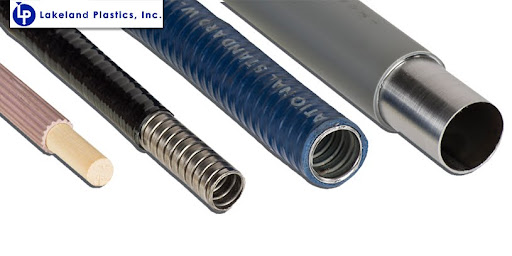Introduction
Talking about innovation, the process stands out for its remarkable contribution to superior bonding that is Crosshead Extrusion Coating. This revolutionary technique has transformed the landscape of coating applications, ensuring unparalleled durability and resilience across various substrates. Let’s delve into the intricate science behind this marvel of engineering.
Unraveling Crosshead Extrusion Coating
Crosshead Extrusion coating involves the meticulous operation of guiding a substrate through a 90-degree crosshead while simultaneously extruding a protective coating over it. This process serves as the cornerstone for encapsulating materials with a resilient shield, offering unmatched protection and longevity. One of the primary applications of this technique is in providing a plastic covering for wires and cables.
The Evolution of Crosshead Extrusion Coating
Over the years, crosshead extrusion coating has undergone significant refinement, leveraging cutting-edge technology to enhance its capabilities. From its humble beginnings to its current state-of-the-art form, this process has continually pushed the boundaries of what’s possible in the realm of industrial coatings.
Exploring Crosshead Extrusion Coating Capabilities
The versatility of crosshead extrusion coating knows no bounds, with its capabilities extending far beyond conventional applications. Let’s explore some of the diverse substrates that can benefit from this innovative technique:
Diverse Substrates
Cable
Wires and cables receive a robust plastic covering, ensuring insulation and protection against external elements.
Pipe
Steel, aluminum, and copper pipes benefit from a durable coating that enhances their longevity and corrosion resistance.
Electrical Conduit
Waterproof electrical conduits are fortified with a resilient layer, safeguarding them against moisture and environmental factors.
Chain
Industrial chains are coated to withstand wear and tear, prolonging their lifespan and maintaining optimal performance.
Wooden Dowels
Wooden dowels receive a protective layer, enhancing their durability and resistance to moisture and abrasion.
Rope
Coated ropes exhibit enhanced strength and resistance to environmental degradation, making them ideal for various applications.
Innovative Applications
The versatility of crosshead extrusion coating extends beyond traditional substrates, finding innovative applications in various industries. Some noteworthy examples include:
Swing Set Chains
Coated swing set chains boast increased durability and weather resistance, ensuring a safer and more enjoyable playtime experience.
Shopping Cart Handles
Enhanced with a protective coating, shopping cart handles offer improved grip and durability, enhancing user comfort and convenience.
Mop and Shovel Handles
Coated mop and shovel handles exhibit superior durability and resistance to wear, prolonging their lifespan and usability.
Waterproof Electrical Conduit
Electrical conduits coated using this technique provide reliable protection against water ingress, ensuring the safety and integrity of electrical systems.
The Science Behind Superior Bonding
At the heart of crosshead extrusion coating lies a meticulous understanding of materials science and engineering principles. The synergy between substrate and coating material is optimized to achieve seamless adhesion and superior bonding. Factors such as surface preparation, material compatibility, and extrusion parameters play a pivotal role in ensuring the durability and effectiveness of the coating.
Surface Preparation
Before the coating process begins, meticulous surface preparation is essential to ensure optimal adhesion. Surface contaminants are removed, and the substrate is treated to promote bonding and enhance coating adhesion. This preparatory step lays the foundation for a robust and long-lasting coating.
Material Compatibility
The selection of coating materials is crucial in determining the effectiveness of the crosshead extrusion coating process. Compatibility between the substrate and the coating material is carefully evaluated to prevent delamination and ensure seamless integration. Advanced polymer formulations are often employed to achieve the desired balance of flexibility, durability, and adhesion.
Extrusion Parameters
Fine-tuning extrusion parameters is paramount to achieving precise coating thickness and uniformity. Factors such as temperature, pressure, and extrusion speed are meticulously controlled to optimize coating performance and ensure consistent results. Cutting-edge instrumentation and automation technologies are employed to monitor and adjust process parameters in real-time, ensuring unparalleled precision and efficiency.
Conclusion
Crosshead extrusion coating represents a pinnacle of engineering ingenuity, providing unparalleled protection and durability across diverse substrates. Through meticulous surface preparation, careful material selection, and precise control of extrusion parameters, this innovative process ensures superior bonding and performance in various applications. As industries continue to evolve, crosshead extrusion coating remains at the forefront of technological advancement, driving innovation and enhancing product reliability.
Experience the superior performance of crosshead extrusion coating. Contact Lakeland Plastics today to elevate your products with advanced coating solutions. Reach out now for exceptional durability and protection.
Frequently Asked Questions FAQs
- What are the primary applications of crosshead extrusion coating?
Crosshead extrusion coating is commonly used to apply a protective layer on various substrates such as wires, cables, pipes, electrical conduits, chains, wooden dowels, and ropes.
- How does surface preparation contribute to the effectiveness of the coating process?
Surface preparation ensures that the substrate is free from contaminants and properly treated, allowing for optimal adhesion between the substrate and the coating material. This step is crucial for achieving a durable and long-lasting coating.
- What factors influence material compatibility in crosshead extrusion coating?
Material compatibility depends on factors such as the chemical composition of the substrate and the coating material, as well as their physical properties. Compatibility testing is essential to prevent delamination and ensure seamless integration between the two materials.
- How are extrusion parameters optimized to achieve precise coating thickness?
Extrusion parameters, including temperature, pressure, and extrusion speed, are meticulously controlled and fine-tuned to achieve the desired coating thickness. Advanced instrumentation and automation technologies are used to monitor and adjust these parameters in real-time for optimal results.
- Can crosshead extrusion coating be applied to non-traditional substrates?
Yes, crosshead extrusion coating can be adapted to coat a wide range of substrates beyond traditional materials. With innovation and customization, this technique can be applied to novel substrates to meet specific industry needs and challenges.

